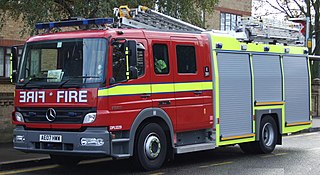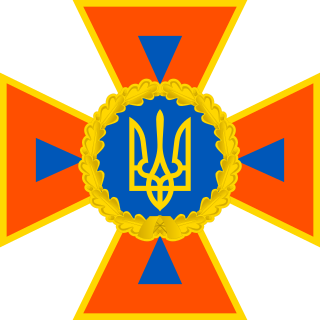Related Research Articles

A firefighter is a rescuer extensively trained in firefighting, primarily to extinguish hazardous fires that threaten life, property, and the environment as well as to rescue people and in some cases or jurisdictions also animals from dangerous situations. Male firefighters are sometimes referred to as firemen.

A fire department or fire brigade, also known as a fire authority, fire district, fire and rescue, or fire service in some areas, is an organization that provides fire prevention, fire suppression, rescue, and hazardous materials mitigation.

The Civil Aviation Authority (CAA) is the statutory corporation which oversees and regulates all aspects of civil aviation in the United Kingdom. Its areas of responsibility include:

For centuries, firefighters have worn helmets to protect them from heat, cinders and falling objects. Although the shape of most fire helmets has changed little over the years, their composition has evolved from traditional leather to metals, to composite helmets constructed of lightweight polymers and other plastics.
Chief fire officer (CFO), formerly often just chief officer, is the highest rank in the fire and rescue services of the United Kingdom. There are currently 50 chief fire officers serving in the United Kingdom in charge of the local authority fire services. There is also a chief fire officer responsible for the Ministry of Defence Fire Services, which includes the Defence Fire and Rescue Service and the RAF Fire Service. Some UK airport fire services also designate their seniors officers as CFOs, though these officers rarely wear the same rank insignia as a local authority chief fire officer.
As firefighting has a rich history throughout the world, traditions in this profession vary widely from country to country.

An airport crash tender is a specialised fire engine designed for use in aircraft rescue and firefighting at aerodromes, airports, and military air bases.

The fire services in the United Kingdom operate under separate legislative and administrative arrangements in England and Wales, Northern Ireland, and Scotland.
The following outline is provided as an overview of and topical guide to firefighting:

The National Fire Service (NFS) was the single fire service created in Great Britain in 1941 during the Second World War; a separate National Fire Service was created in 1942.

Cyril Thomas Demarne, was a British firefighter. He served in London during the Second World War, throughout the Blitz. He was later involved in establishing aviation firefighting units in Australasia and in Beirut. In retirement, he wrote several books based on his wartime experiences.

The British Civil Air Ensign is the flag that may be flown at civil aviation establishments in the United Kingdom and be displayed on UK-registered civil aircraft. It should be flown at civilian air facilities as the national flag in place of the Union Flag.
The title and job role of Her Majesty's Chief Inspector of Fire and Rescue Services in England, Scotland and Wales is combined with that known as Fire and Rescue Adviser appointed by the devolved and national governments of the United Kingdom.

Firefighting has historically been a predominantly male profession throughout the world. However, since the 1970s, women have made inroads in both professional and volunteer fire departments in multiple countries. In modern times, women have served in a variety of fire service roles including as fire chiefs. Nonetheless, they comprise less than 20% of firefighters even in the countries where they are best represented.
Firefighting is the act of extinguishing destructive fires. A firefighter fights these fires with the intent to prevent destruction of life, property and the environment. Firefighting is a highly technical profession, which requires years of training and education in order to become proficient. A fire can rapidly spread and endanger many lives; however, with modern firefighting techniques, catastrophe can usually be avoided. To help prevent fires from starting, a firefighter's duties include public education and conducting fire inspections. Because firefighters are often the first responders to victims in critical conditions, firefighters often also provide basic life support as emergency medical technicians or advanced life support as licensed paramedics. Firefighters make up one of the major emergency services, along with the emergency medical service, the police, and many others.
The provision of rescue and firefighting services (RFFS) at all airports and aerodromes in the United Kingdom is a requirement under British law and under international agreements set out by the International Civil Aviation Organization.
Aviation in the United Kingdom refers to the activities surrounding mechanical flight in the United Kingdom, in both civilian and military contexts.

The State Emergency Service of Ukraine, until December 24, 2012 the Ministry of Emergencies of Ukraine, is the main executive body tasked with carrying out state policy in the spheres of civil defence, rescue, creating and managing the system of insurance fund documentation, utilization of radioactive wastes, protection of population and territory in emergency situations, emergency prevention and response, liquidation in the aftermath, and the Chernobyl catastrophe.
Airport policing in the United Kingdom has taken many forms since the rise of scheduled airline services in the post-war period. Policing at major civilian airports was the responsibility of specialist constabularies operated by three central government departments until 1974, when the rise in international terrorism saw armed police from territorial police forces deployed to major airports under the provisions of the Policing of Airports Act. As more minor airports grew in size, they too switched to armed police provided by local police forces. However, the funding agreements for the provision of such services varied wildly from airport to airport, leading to disagreements between airport operators and chief constables. A new regime, the Airport Security Planning Framework, came into force in January 2010, and brought airport operators, airlines and police forces together to develop joint security and policing plans for all passenger airports.
Leslie William Thomas Leete was an English firefighter who became chief fire officer of the London Fire Brigade from 1962 to 1970 – the first LFB chief to have served in every rank within the Brigade.
References
- ↑ "civil aviation | ministry | air ministry | 1954 | 0070 | Flight Archive". www.flightglobal.com. Archived from the original on 14 February 2009.
- ↑ Civil Service Arbitration Tribunal: Judgment re claim for increase of salary scales for Fire Service Officers employed by the Ministry of Civil Aviation, 15 March 1952